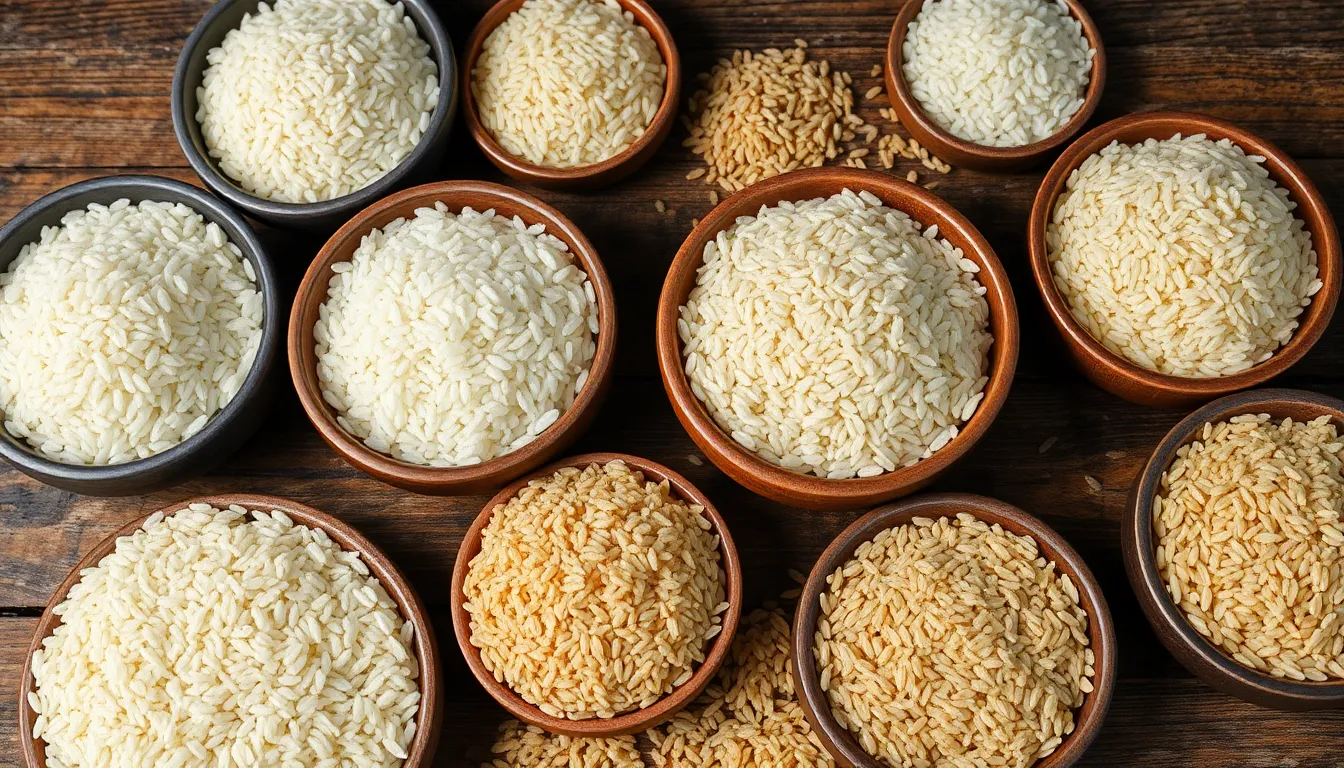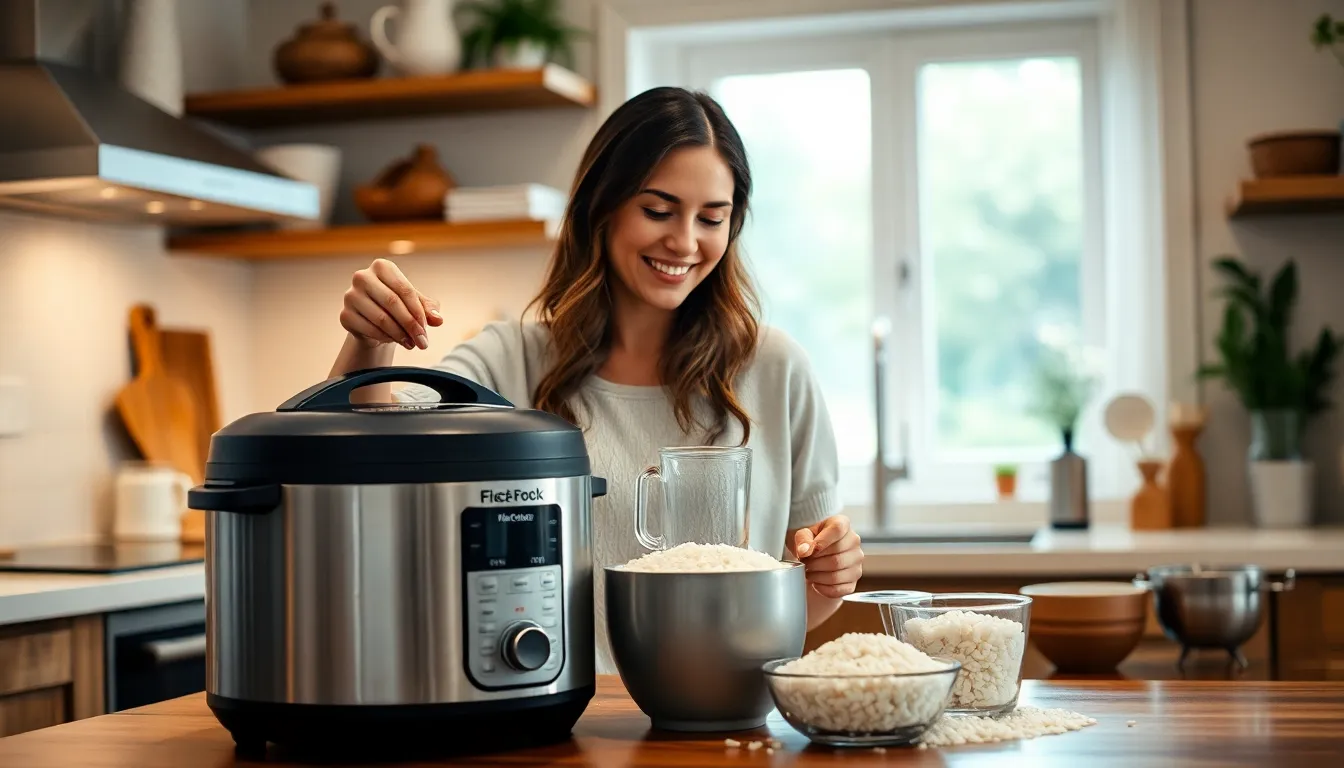Cooking rice perfectly can be a challenge, but understanding the right rice-to-water ratio simplifies the process. Using a rice cooker takes the guesswork out of meal prep, allowing for fluffy, delicious rice every time. Whether it’s jasmine, basmati, or brown rice, knowing the correct measurements is key to achieving that ideal texture.
Many home cooks often struggle with ratios, leading to undercooked or mushy rice. This article dives into the essential rice cooker ratios for various types of rice, ensuring that anyone can master this staple food. With just a few simple guidelines, preparing rice becomes an effortless task that complements any dish.
Table of Contents
ToggleUnderstanding Rice in Rice Cooker Ratio
Achieving the perfect rice texture requires understanding the rice-to-water ratio. This ratio varies based on the type of rice used. Here’s a guide for common rice types:
- White Rice
Two cups of water for each cup of white rice yield fluffy, tender results.
- Jasmine Rice
Use 1.5 cups of water for each cup of jasmine rice for optimal softness and aroma.
- Basmati Rice
Combine 1.5 cups of water with each cup of basmati rice to maintain its distinctive flavor and fluffiness.
- Brown Rice
Use two and a half cups of water for each cup of brown rice, as it requires more moisture for even cooking.
- Wild Rice
For wild rice, apply three cups of water for every cup of rice, as it generally takes longer to cook.
Measuring accurately is crucial for consistent results. Use a standard measuring cup and level off at the top without packing the rice. After adding rice and water to the rice cooker, it’s important to avoid opening the lid during the cooking process. Opening it can release steam, affecting the cooking time and texture of the rice.
Following these ratios helps cooks achieve the desired outcome with different rice types. The right measurements simplify the cooking experience in a rice cooker, making it easy to prepare any meal.
Factors Influencing Rice in Rice Cooker Ratio

The rice-to-water ratio varies based on several factors. Understanding these influences ensures optimal results when cooking rice in a rice cooker.
Type of Rice
Different rice types require distinct water ratios for optimal cooking.
- White Rice: Typically requires a 2:1 ratio (two cups of water for each cup of rice).
- Jasmine Rice: Needs a 1.5:1 ratio, providing a slightly softer texture.
- Basmati Rice: Also uses a 1.5:1 ratio, ensuring fluffy, separate grains.
- Brown Rice: Demands a 2.5:1 ratio due to its tougher bran layer, which absorbs more water.
- Wild Rice: Requires a higher 3:1 ratio, as it takes longer to cook and needs more hydration.
Desired Texture
The texture preference influences the rice-to-water ratio.
- Fluffy Rice: For a fluffier texture, use the standard ratios, avoiding excess water.
- Creamy Risotto Style: Increase water slightly, aiming for a more mushy consistency, ideal for risotto or similar dishes.
- Sticky Rice: To achieve sticky rice, reduce water to create a more cohesive texture, useful for sushi or certain Asian dishes.
Understanding these factors aids in mastering the rice cooking process. Adjusting ratios according to rice type and desired texture guarantees more satisfying results.
General Guidelines for Rice in Rice Cooker Ratio
Understanding the rice-to-water ratio is essential for achieving perfectly cooked rice. Specific ratios depend on the type of rice to ensure the best texture and flavor.
Common Ratios for Different Rice Types
| Rice Type | Water Ratio |
|---|---|
| White Rice | 2 cups of water per cup of rice |
| Jasmine Rice | 1.5 cups of water per cup of rice |
| Basmati Rice | 1.5 cups of water per cup of rice |
| Brown Rice | 2.5 cups of water per cup of rice |
| Wild Rice | 3 cups of water per cup of rice |
Each type of rice has a unique water requirement. White rice requires a standard 2:1 ratio for ideal fluffiness. Jasmine and basmati rice need slightly less water, leading to a light and aromatic finish. Brown rice needs more water due to its bran layer, while wild rice requires the most, reflecting its longer cooking time and denser texture.
Measuring Techniques
Measuring accurately affects the cooking process significantly. Use a standard measuring cup for precision. Ensure that water levels are adjusted based on preferences, such as slightly increasing water for creamier rice or reducing it for stickier textures. It’s essential to avoid common mistakes, like using a regular cup instead of a measuring cup, as this can lead to inconsistent results. Using clear markings on the rice cooker pot can also assist in achieving the correct ratios.
Troubleshooting Rice Cooking Issues
Home cooks may encounter several issues while using a rice cooker. Recognizing common mistakes and knowing how to address them can lead to consistently delicious rice.
Common Mistakes
- Incorrect Rice-to-Water Ratio: Often, cooks miscalculate the rice and water amounts. Each rice type has specific requirements; using the wrong ratio leads to undercooked or overcooked rice.
- Not Rinsing Rice: Failing to rinse rice can cause excess starch, resulting in clumpy or gummy texture. Rinsing removes this starch, improving the final product.
- Opening the Lid During Cooking: Opening the lid interrupts the cooking process. This act causes steam loss, preventing proper cooking and texture.
- Neglecting Rice Cooker Instructions: Ignoring the manufacturer’s guidelines may lead to issues. Each rice cooker has unique features, affecting cooking times and water requirements.
Solutions to Common Problems
- Adjust the Ratio: Always refer to the specific rice-to-water ratio for the rice type chosen. Use accurate measuring tools to ensure consistency.
- Rinse Rice Properly: Rinsing rice under cold water until the water runs clear helps achieve optimal texture. This step is crucial for long-grain varieties and those prone to stickiness.
- Avoid Lid Interference: Leave the lid closed during the entire cooking cycle. Follow the recommended cooking time to retain steam and heat for even cooking.
- Read the Manual: Familiarize yourself with the rice cooker’s instructions. Understanding its settings, features, and recommended ratios can greatly enhance cooking results.
Mastering the rice-to-water ratio is essential for achieving perfect rice every time. By understanding the specific needs of different rice types and following the recommended guidelines, home cooks can simplify their cooking process. Utilizing a rice cooker not only streamlines preparation but also guarantees fluffy and delicious results.
With accurate measurements and attention to detail, cooks can avoid common pitfalls and enhance their meals effortlessly. Embracing these techniques will transform rice cooking from a challenge into a rewarding experience, bringing satisfaction to every dish.




